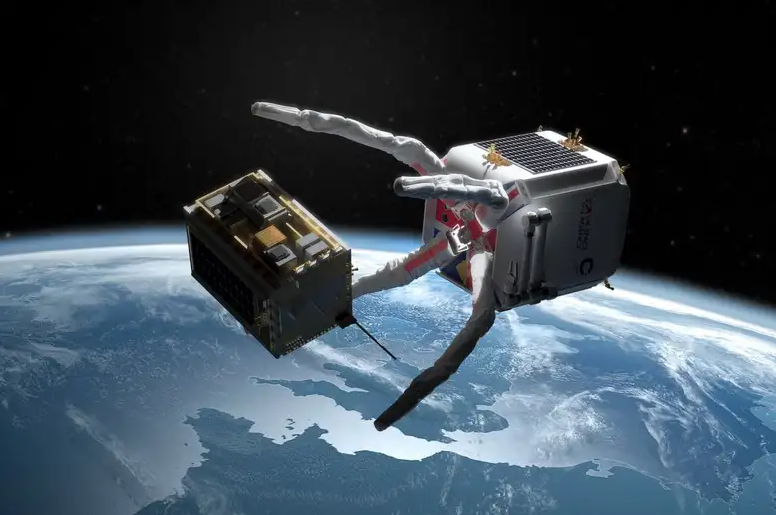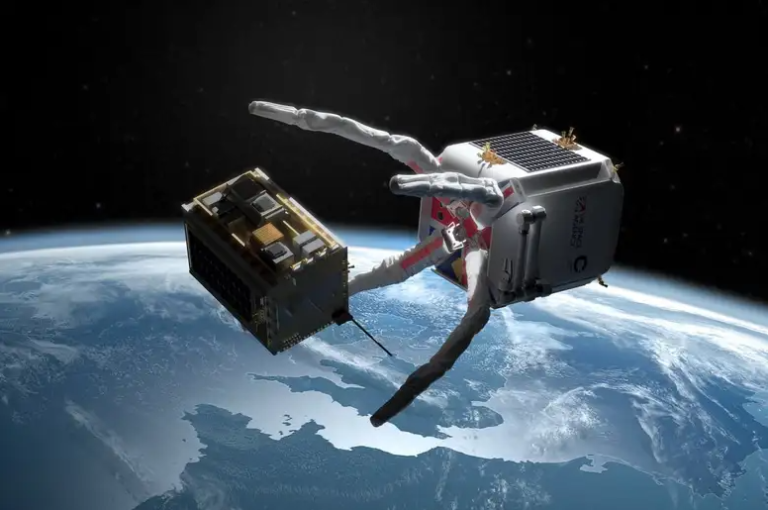UK wants to send a spacecraft to grab two dead satellites from space
The UK is putting £5 million towards a mission to remove two dead satellites from space by burning them up in Earth’s atmosphere
The UK is committing £5 million to fund a mission to remove space junk. The project will aim to bring two defunct satellites back through Earth’s atmosphere later this decade – a first-of-its-kind feat.
Speaking today at the Secure World Foundation’s Summit for Space Sustainability in London, the UK’s science minister George Freeman outlined the country’s commitment to keeping Earth’s orbit clean and tidy as part of the UK’s Plan for Space Sustainability. This includes drawing up regulatory norms for the safe operation of satellites and lowering insurance costs for sustainable missions.

“We’re at the cusp of a massive explosion of satellites,” said Freeman. “We want to make sure we lead in the science of sustainability.”
The UK’s Active Debris Removal mission, first announced last year, will see a spacecraft launched into orbit in 2026. Once there, it will journey to two dead UK satellites orbiting our planet and pull them back into the atmosphere so they burn up, proving that a single spacecraft can remove more than one piece of debris.
“Removing multiple pieces of debris with a single vehicle is the right way to go,” says Hugh Lewis at the University of Southampton, UK. More than 30,000 pieces of debris in Earth’s orbit are tracked today, including some 2500 dead satellites.
Read more: The rise of SpinLaunch, the company planning to hurl things into space
Current debris removal plans, such as an upcoming mission by Swiss company ClearSpace in 2025, funded by the European Space Agency, are focused on removing just one piece of debris. The UK’s mission will be the first to target multiple pieces, with the removal spacecraft designed to be left in Earth orbit, possibly available for refuelling in future to tackle more junk.
Three companies are vying for the contract: ClearSpace, Japanese-UK company Astroscale and UK-based Surrey Satellite Technology (SSTL). Two will be selected to share the £5 million fund in July, then a single firm will be picked for the mission by the end of 2023 with a contract worth up to £60 million.
“Space debris is a huge problem,” said Freeman. “The aim is to make the UK a world leader in satellite retrieval systems.”
Each company has a different proposed method to carry out the mission. Astroscale would use a robotic arm to grab each dead satellite, Clearspace plans to use four arms to “hug” the objects and pull them down, while SSTL is investigating the possibility of using a giant net to grab one and pulling the other down with an arm.
The two defunct UK satellites that will be selected have yet to be chosen from more than a dozen targets. While there are no major legal hurdles to a country targeting its own satellites, there are some mission issues that will need to be cleared with the Civil Aviation Authority in the UK, says Joanne Wheeler, a lawyer at London-based firm Alden Legal. “What happens if you go up there and attach to the wrong object?” she asks, saying it could be a national security issue.
The hope is that the scheme, which has the largest fund for a single UK space mission, will spur more commercial debris-removal missions. “We’re trying to speed up the development of these technologies,” says Jacob Geer at the UK Space Agency. “We’re sending one satellite to remove two objects. There’s a net loss in the amount of objects in space. It’s an important step for everyone, not just the UK.”
Source: NewScientist
Do not forget to share your opinion with us to provide you with the best posts !




0 Comments